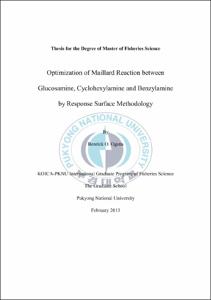Optimization of Maillard Reaction between Glucosamine, Cyclohexylamine and Benzylamine by Response Surface Methodology
- Abstract
- Individual Maillard reactions of glucose, glucosamine, cyclohexylamine and benzylamine were studied at a fixed temperature of 120°C under different durations by monitoring the absorbance of the final products at 425 nm. Glucosamine was the most individually reactive compound whereas the reactions of glucose, cyclohexylamine and benzylamine were not significantly different from each other (p>0.05). Maillard reactions of reaction pairs consisting of glucosamine-cyclohexylamine, glucosamine-benzylamine, glucose-cyclohexylamine and glucose-benzylamine were also studied using different concentration ratios under different durations at a fixed temperature of 120°C and pH 9. Maillard reactions in the pairs involving glucosamine were observed to be more intense than those of the pairs involving glucose. Finally, with respect to the concentration ratios, it was observed that in most instances optimal activity was realized when the reaction pairs were in the ratio of 1:1.
Maillard reaction between glucosamine and benzylamine was optimized by use of the central composite design for response surface methodology with 30 experimental runs. The central composite design matrix comprised of a total of 16 factorial levels, 8 axial levels and 6 centre levels. In the design, concentration ratio, pH, temperature and time were used as independent variables whereas absorbance, Hunter’s Lab colour scale L, a and b values were used as response factors. The Hunter’s Lab colour scale L, a and b values were used to calculate delta E (∆E) which was consequently set as the fifth response factor. The central composite design matrix showed that maximum absorbance (after a tenfold dilution) can be achieved with the independent variables set at a concentration ratio of 1.2 (glucosamine 0.06 M: benzylamine 0.04 M), pH 9, temperature 120°C and time 2 hours. The quadratic models for predicting the values of the absorbance and ∆E (after a tenfold dilution) obtained by multiple polynomial regression revealed the most significant independent variables to be temperature, pH and time, respectively. The models also revealed the most significant interaction to be the pH*temperature interaction.
Maillard reaction between glucosamine and cyclohexylamine was optimized by use of the central composite design for response surface methodology with 50 experimental runs. The central composite design comprised of a total of 32 factorial levels, 10 axial levels and 8 centre levels. In the design, glucosamine concentration, cyclohexylamine concentration, pH, temperature and time were used as independent variables whereas absorbance, Hunter’s Lab colour scale L, a and b values were used as response factors. The Hunter’s Lab colour scale L, a and b values were used to calculate ∆E which was consequently set as the fifth response factor. The central composite design matrix showed that maximum absorbance (after a tenfold dilution) can be achieved with the independent variables set at glucosamine concentration 0.08 M, cyclohexylamine concentration 0.08 M, pH 9, temperature 85°C and time 2 hours. The quadratic models for predicting the values of the absorbance and ∆E (after a tenfold dilution) obtained by multiple polynomial regression revealed the most significant interactions to be the temperature*time and pH*time interactions, respectively.
- Issued Date
- 2013
- Awarded Date
- 2013. 2
- Type
- Dissertation
- Publisher
- 부경대학교
- Affiliation
- 부경대학교 대학원
- Department
- 대학원 국제수산과학협동과정
- Advisor
- 이양봉
- Table Of Contents
- List of Figures iii
List of Tables v
Abstract vii
CHAPTER 1: Optimization of Maillard Reaction between Glucosamine and Other Precursors by Measuring Browning with a Spectrophotometer 1
Abstract 1
Introduction 2
Materials and Methods 6
Materials 6
Methods 7
Statistical Analyses 8
Results and Discussion 9
Individual Maillard Reactions 9
Browning of Reaction Mixtures 11
Conclusions 17
References 19
CHAPTER 2: Optimization of Maillard Reaction between Glucosamine and Benzylamine by Response Surface Methodology 21
Abstract 21
Introduction 22
Materials and Methods 25
Materials 25
Methods 25
Statistical Analyses 27
Results and Discussion 28
Response Surface Modelling for Absorbance 28
Response Surface Modelling for ∆E 32
Conclusions 38
References 39
CHAPTER 3: Optimization of Maillard Reaction between Glucosamine and Cyclohexylamine by Response Surface Methodology 41
Abstract 41
Introduction 42
Materials and Methods 45
Materials 45
Methods 45
Statistical Analyses 47
Results and Discussion 48
Response Surface Modelling for Absorbance 48
Response Surface Modelling for ∆E 54
Conclusions 58
References 59
- Degree
- Master
- Appears in Collections:
- 글로벌수산대학원 > 국제수산과학협동과정
- Files in This Item:
-
-
Download
 Optimization of Maillard Reaction between Glucosamine, Cyclohexylamine and Benzylamine by Response S.pdf
기타 데이터 / 1.08 MB / Adobe PDF
Optimization of Maillard Reaction between Glucosamine, Cyclohexylamine and Benzylamine by Response S.pdf
기타 데이터 / 1.08 MB / Adobe PDF
-
Items in Repository are protected by copyright, with all rights reserved, unless otherwise indicated.